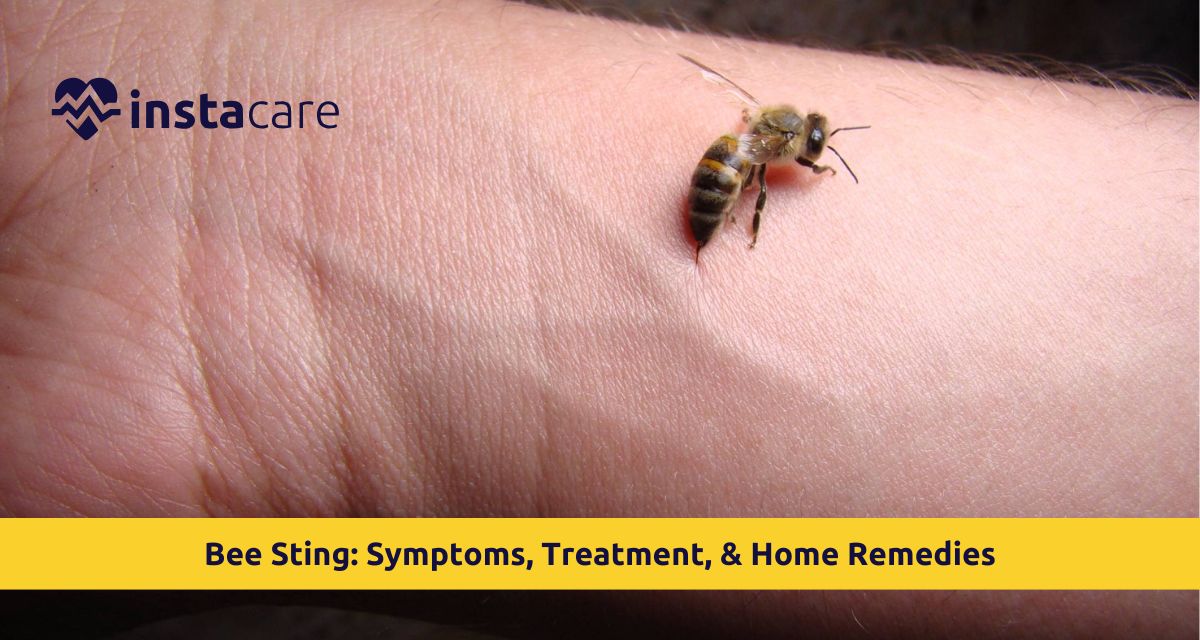This is a general guide detailing what is bee sting, symptoms to look out for, treatment and even bee sting home remedies, and how to prevent bee stings. The guide also illustrates how bee sting vs wasp sting differs in key aspects like pain, venom, and risk.
What Happens When a Bee Stings You?
When it stings, the bee injects the stinger and venom into the skin. Venom are proteins that act upon the immune system and the skin cells and bring about pain and bee sting swelling. Honeybee stinger is barbed and gets stuck in the skin and pulled out of the bee's abdomen, killing the bee. Other insects like wasps sting repeatedly without damaging their stinger.
The immune system of the body responds rapidly to the venom. Redness, swelling, and pain at the site of the sting are all results of the body's immune response. Such a person's reaction is normally mild in most people but resolves after hours or days. The allergic reaction to bee sting would require immediate action in an allergic person as it is able to produce extreme responses.
Symptoms of Bee Sting Often Experienced
The overwhelming majority of bee sting symptoms is local and present with:
- Burning and tenderness on the area of the sting
- Redness and swelling
- White pustule on the area of the sting
- Heat and itching over the area of the sting
Symptoms will typically have disappeared in several hours, but swelling is cumulatively obtained in the first 24–48 hours before subsiding.
Symptoms of Allergic Reaction
Others would experience an increased immune response. Symptoms of bee sting allergy symptoms are:
- Swelling away from the sting location
- Hives or itch at a different part of the body
- Shortness of breath or wheezing
- Light-headedness or syncope
- Tachycardia or hypotension
Bee sting and anaphylaxis is a potentially life-threatening type of allergic reaction, and it requires immediate emergency care.
First Aid & Medical Treatment
First Aid Steps
The following bee sting first aid measures should be taken immediately:
- Get rid of the stinger as rapidly as possible with a flat object such as a credit card. Do not use tweezers since it will drive the venom deeper into the skin.
- Clean the sting area with soap and water to prevent bee sting infection.
- Apply a cold pack or ice for 15-20 minutes to alleviate pain and bee sting pain relief.
- Lift the injury, if at all feasible, particularly if stung on the arm or leg.
- Take ibuprofen for pain or antihistamine for itch over-the-counter.
When to Visit a Physician
Knowing when to see a doctor for bee sting can be critical:
- You are experiencing difficulty in breathing
- Swelling is rapidly spreading
- You are dizzy or lightheaded
- You have an existing allergy to bee stings
- You have been stung repeatedly (especially more than 10 times)
- Evidence of infection occurs (pus, redness spreading, heat)
Physicians can restore a serious reaction by:
- Epinephrine (EpiPen) for bee sting treatment of anaphylaxis
- Injectables or oral antihistamines
- Steroids to manage inflammation
- IV fluids and oxygen in serious cases
Home Remedies for Bee Stings
In minor, non-allergic reaction, the following bee sting remedies can be attempted for relief and quick recovery:
- Baking Soda Paste: Mix water and baking soda and make paste and apply over sting. It will neutralize poison and relieve itching.
- Honey: Honey that is collected by bees softly will ease swelling and keep infection away. Use sparingly on the sting and bandage.
- Apple Cider Vinegar: Vinegar is designed to erase bee venom. Soak a pad in diluted vinegar and apply for 15 minutes.
- Aloe Vera Gel: Aloe vera calms skin and heals quicker. Apply gel on the stinging spot.
- Toothpaste: Toothpaste ought to neutralize the venom and stop the burning, though scientifically it doesn't.
- Essential Oils: Tea tree oil (mixed with carrier oil) or lavender oil can have antiseptic and anti-inflammatory effects.
Those looking for advice on how to treat a bee sting at home may find these simple remedies helpful. Note: Always do a patch test to check for any sensitivity.
Preventing Bee Stings
While it may be impossible to entirely avoid bee stings, there are ways to reduce your chances:
- Avoid using strong perfumes or scented skin moisturizers outdoors
- Wear light clothing; bees dislike dark and floral print clothing
- Keep food and drinks covered when dining outdoors
- Don't go into a tizzy when bees are buzzing around you, don't swat and frantically run around them
- Wear shoes outdoors, especially on grass
- Secure trash cans to prevent bee attraction
- Keep car windows rolled up in bee-prone areas
For individuals at high risk, carrying an EpiPen and alerting those around you about allergies is essential.
Bee Sting vs. Wasp Sting
Bee sting vs wasp sting both carry very similar effects like pain, redness, and swelling but carry an enormously vast difference as well. A barbed stinger is used in a bee sting, which gets embedded in the skin, releasing venom until they are pulled out. Bees are killed through stinging because their stinger is ripped off from their body. Wasps possess smooth stingers and they sting again and again without damaging themselves.
The bee venom is acidic, while that of the wasp is alkaline and exerts some influence on the body reaction. The pain from wasp stings is more severe. Both can require bathing of the affected region, but in addressing swelling or pain, bee stings alone must have the stinger removed.
Conclusion
Bee sting is generally a nuisance but occasionally fatal. Early diagnosis of symptoms and first aid is life and death. Use of cold compresses or other native remedies like honey and aloe vera, early treatment guarantees speedy recovery. But if anyone has an acute allergic reaction, call emergency immediately.
How long does a bee sting last? Typically 1–3 days, but with proper care, healing is smooth and quick. Learn to identify the warning signs and be prepared, because knowing what to do will make all the difference.
Please book an appointment with the
Best General Physician in Lahore, Karachi, Islamabad, and all major cities of Pakistan through
InstaCare, or call our helpline at 03171777509 to find a verified doctor for your disease.

